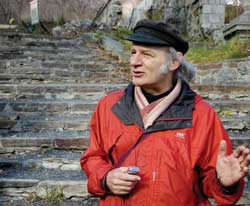Class takes to the streets

Jean Bélisle leads his class to discover Montreal up close and on foot.
Photo by rob maguire
You probably don’t realize that picnickers in Dorchester Square are just a couple of feet above the remains of former Montrealers.
That is the type of information that Jean Béslisle’s art history students learn while they wander Montreal’s streets to experience the architecture, planning and logic that built this city.
“I used to teach this course with slides, but then I thought… I could teach one about Paris with slides, but we are in Montreal.” Bélisle (Art History) teaches courses on architecture and sculpture.
For Bélisle, having students on the street enables them to experience the buildings they are talking about and understand how they relate to their surroundings, to each other, and to the larger city. “I get them to articulate their experience. The EV building is a new building, and when they start talking about it, they understand how they are led to react a certain way to the height of a space, or the way light enters it.”
Bélisle talks about the Dorchester (formerly Dominion) Square cemetery in a tour that covers the English and French elite from the mid-1800s to the 1920s.
That cemetery represented the edge of town. But by the 1840s, it was full. So the cemetery moved to the mountain and the anglo elite began to build their mansions in what is now downtown.
Many of those buildings remain. Bélisle took his students past the Mount Stephen Club, once the home of George Stephen, who made his fortune with the Canadian Pacific Railway. Students continued past the homes of other transportation millionaires, along with homes belonging to generations of leading families, like the Molsons, the Allans and the Rosses.
Along the way, Bélisle commented on the architects of the day; half of the Golden Square Mile mansions were designed either by the Maxwell brothers or Robert Findley. Many of the homes were architectural anomalies, appealing to the tastes of their well-heeled owners.
Some, like the Sola house on Pine Ave., are odes to a particular style. The Moorish villa seems out of place down the street from the art deco palace built by architect Ernest Cormier and now owned and occupied by the Trudeau family.
Bélisle acknowledges that this tour, which meanders through the cemetery (where the French and English sections are separated by a door) through the Université de Montréal and some key buildings of the French elite (divided from the anglos by the mountain itself), is longer and more ambitious than most.
“But it’s important for students to experience how the areas relate to each other. And how 15 minutes from skyscrapers they are in the middle of a forest.”
Each week students see a different pocket of the city. One of the early tours takes them up the Main, St. Lawrence Blvd. “It symbolically cuts the city in two. Many of the later tours cross it at some point, so the students can relate back to what they learned.”
After 10 years, Bélisle is still modifying his course. Each tour starts at a spot easily accessible by public transit and ends a half hour away from Concordia, so students can get to their next class.
There is always a waiting list for the course. “Over half of them are not Fine Arts students. A lot are from Urban Planning.”